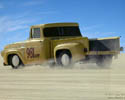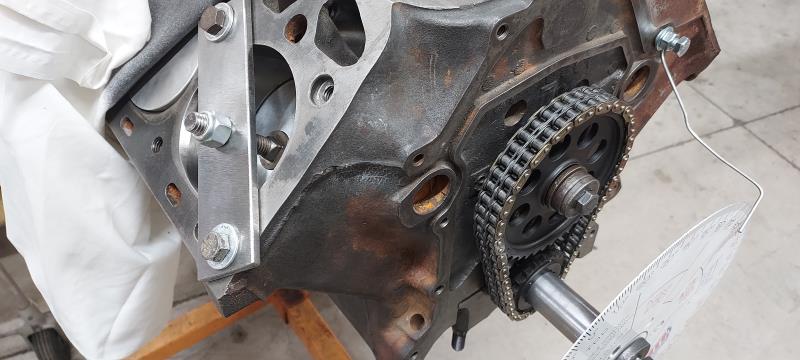|
Author
|
Message
|
|
bird55
|
|
|
Group: Forum Members
Last Active: 2 Years Ago
Posts: 1.1K,
Visits: 58.8K
|
Glad to see you are back at it. The insides look good. Maybe I'll see you on the Salt this year.
A L A N F R A K E S ~ Tulsa, OK
|
|
|
|
|
57FordPU
|
|
|
Group: Forum Members
Last Active: 3 Years Ago
Posts: 726,
Visits: 73.6K
|
Hi, Allen. It would be good to see you out there. My plan is to attend Speed Week for the first time since 2016. September and October are better for lots of reasons, but the best chance for good salt and weather is in August.
Charlie Burns Laton, Ca (South of Fresno)

BurnsRacing981@gmail.com
|
|
|
|
|
57FordPU
|
|
|
Group: Forum Members
Last Active: 3 Years Ago
Posts: 726,
Visits: 73.6K
|
Degreeing in the cam is a vital process in building any serious engine. The details and understanding while watching over the shoulder of professionals like Tim McMaster have never given me confidence to try it on my own. However, this time I am by myself here in Southern Oregon when it comes to racing Y-Blocks and I decided to take on the task.
The purpose is to make sure the cam you just installed matches the cam card that came with it. Machining mistakes are rare, but pulling the wrong cam off the shelf and putting it in the box with your cam card is a bigger possibility.
To be continued.........
Charlie Burns Laton, Ca (South of Fresno)

BurnsRacing981@gmail.com
|
|
|
|
|
57FordPU
|
|
|
Group: Forum Members
Last Active: 3 Years Ago
Posts: 726,
Visits: 73.6K
|
First and foremost, a disclaimer is in order. In no way is the following suggested to be a tutorial on degreeing in a cam. It is just an explanation of how it worked for me. Professionals (I don’t have to name any names) will have different procedures and tools to accomplish the same task in a manor that works best for them.
My intent is purely to help those who may be curious or may not have the confidence to try it themselves. Sometimes it just takes one little thing for the light to come on and self confidence will follow.
Charlie Burns Laton, Ca (South of Fresno)

BurnsRacing981@gmail.com
|
|
|
|
|
57FordPU
|
|
|
Group: Forum Members
Last Active: 3 Years Ago
Posts: 726,
Visits: 73.6K
|
The number one task for me was to determine absolute Top Dead Center (TDC) on the compression stroke of the #1 piston. All of the following measurements will be suspect if TDC is not first determined.
Using a dial indicator (Harbor Freight works great for me) is a must with perhaps a magnetic base that allows multiple positioning. The start of the process is to bring up the #1 piston to TDC on the compression stroke as best I could. Realizing that pistons have top end play, I felt like it could rock during the measuring with the dial indicator operation and give a false reading. Placement of the dial indicator on the axis of the connecting rod seemed to be the best placement and in the center felt like the best location.
Charlie Burns Laton, Ca (South of Fresno)

BurnsRacing981@gmail.com
|
|
|
|
|
57FordPU
|
|
|
Group: Forum Members
Last Active: 3 Years Ago
Posts: 726,
Visits: 73.6K
|
When I say "best I could" when bringing up the piston to TDC on the compression stroke, it has two explinations.
First, If the valley cover is off, you can watch the valve action on the lifters and when the piston is at TDC on the compression stroke, both intake and exhaust lifters are in the down (or closed) position.
Secondly, after I determined the piston was coming up on the compression stroke, I tried to stop it at TDC. Notice "tried". I had to realize that when the piston is at the top of it's stroke, there is a dwell moment when it seems not to move while the crank is actually still rotating. Hence, the need for the exact TDC to be determined.
It was time to start the measuring.........
Charlie Burns Laton, Ca (South of Fresno)

BurnsRacing981@gmail.com
|
|
|
|
|
Cliff
|
|
|
Group: Forum Members
Last Active: Yesterday
Posts: 881,
Visits: 13.5K
|
Hi Charley, the way I find TDC is to make a stop (strap across the top of the piston) with a bolt, I turn the engine until the piston hits the stop, I record the number on the wheel, then I turn it the other direction till it hits the stop, divide in 1/2 that's TDC.
|
|
|
|
|
57FordPU
|
|
|
Group: Forum Members
Last Active: 3 Years Ago
Posts: 726,
Visits: 73.6K
|
Placing the dial indicator arm on the piston and giving it some preload to insure constant contact, I revolved the outer edge to align the needle to 0° on the gauge. Is this TDC? Not yet.
If not already performed, the placement of the degree wheel on the end of the crank and a bendable pointer now come into play. Ironically, it was not necessary for the TDC on the wheel to placed absolutely straight up when starting the process (I placed it at about the 2 o'clock position). Actually, any position of TDC on the wheel can be placed to better enable me to read it. With my "coat hanger wire" pointer attached to one of the right side timing cover holes, I bent it to make the wheel read 0° TDC.
Now comes the fun stuff........
Charlie Burns Laton, Ca (South of Fresno)

BurnsRacing981@gmail.com
|
|
|
|
|
57FordPU
|
|
|
Group: Forum Members
Last Active: 3 Years Ago
Posts: 726,
Visits: 73.6K
|
Hi, Cliff. You are right, below is the strap you speak of that I made to try both methods. I used a carriage bolt to protect the piston and placed it about 1 1/2" in the hole. This would be a great tool to use when you were placing a custom pointer on the damper and you don't have a dial indicator. Please help me with the math you speak of, as I used a different method and came up with the same result for TDC as when I used the dial indicator.
 Charlie Burns Laton, Ca (South of Fresno)
Charlie Burns Laton, Ca (South of Fresno)

BurnsRacing981@gmail.com
|
|
|
|
|
Cliff
|
|
|
Group: Forum Members
Last Active: Yesterday
Posts: 881,
Visits: 13.5K
|
Hi, move the bolt up to the top so it stops the piston about 1/2" down the bore, bring up the piston till it hits the stop then set the degree wheel to zero, then turn the crank to the other direction until it hits the stop again then record the number on the degree wheel, divide that number in 1/2 that will be TDC on the degree wheel (if it reads 40 then TDC will be at the 20 mark on the wheel)
|
|
|
|